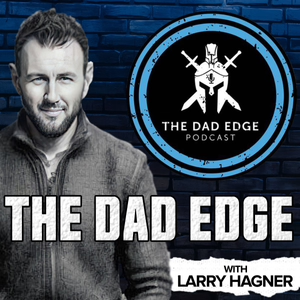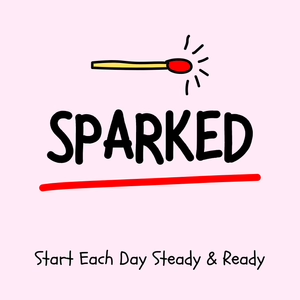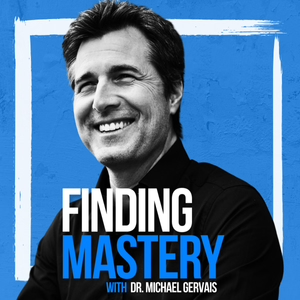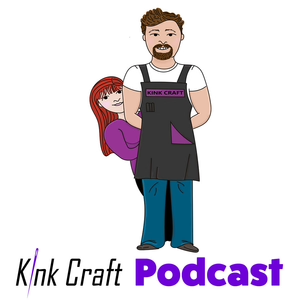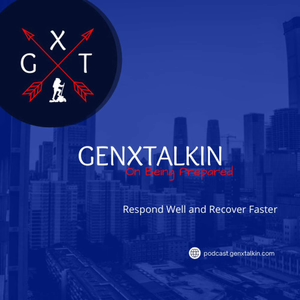
GenXTalkin Making a Plan - Shelter in Place and Evacution Planning GXT-EP05-01
09/28/21 • 77 min
YOUTUBE VIDEO
https://youtu.be/2XlOcaRnqp4
RESOURCES
- https://www.ready.gov/
- National Risk Index MAP
-- https://hazards.fema.gov/nri/map
- I’m Matt Damon
-- https://youtu.be/gnPWJOJYVKc
- Bourne Identity Scene
-- https://youtu.be/dsJiYWv3J00
Show Notes:
Hey there all you GenXers. Great to be back again for an exciting show on Making Plans for Preparedness. I’m Matt Marshall overall preparedness enthusiast... and I’m here to remind us all with preparedness comes comfort, with preparedness comes peace, something we could all use a bit more of...
With all that said,. Onto the show! It is National Preparedness Month, and that mainly means we focus on two things, making a plan and creating a go bag. We’ve spent some time in a couple of past episodes talking about the different types of bags; edc, go-bag and bug out bags, and the get home safe bag. And for sure we’ll dig deeper into these in future episodes.
For today we’re focusing on the other half, making a plan.
I think one of the important concepts around making a plan is first to realize it’s never just one plan at all!
Fire escape plan
Shelter In place plan
Evacuation route planning
Water collection plan
Communications plan
Financial plan
This I’m sure is one of the reasons it can take a while to make a plan - when you consider... all the plans.
Planning to Shelter In Place
For Shelter in place I personally think, and I believe most preparedness-minded people walk this same path, that it’s important to first define what are your greatest threats. If you know what you and your community are most at risk of encountering, then you can more easily prepare to combat them.
We review the types of threats:
- High Impact, High Frequency
- High Impact, Low Frequency
- Low Impact, High Frequency
- Low Impact, Low Frequency
Planning to Evacuate or Get Out Quick
The government recommends having a Bugout, or Go Bag in the event you have to get away from home quickly. And most preparedness minded organizations add onto this in saying, within 15 minutes, you should be ready to go with all you need for at least 72 hours, but supplies for one week is even better.
As well, if you travel for work, get in the habit of doing this in hotels, airports and your temporary place of work. Good to at least get a basic idea of layouts.
Next, create a fire escape plan at home. Also consider where your gathering points might be staged. There should be two, one right outside the house (near a tree) and one should be slightly further away, like a neighbor's front porch.
————————-
Lastly, you should come to realize that preparedness does not stop at the end of National Preparedness Month... Keep going, and remember that "practice makes PROGRESS!"
@genxtalkin
Would you be prepared? Are you prepared?
Choosing to be more prepared every day is a skill. One that should be honed. Focusing on growing just a little everyday will allow us all to be prepared to respond well and recover faster.
I’d love to hear your thoughts and comments about prepping, so please reach out and share as you can.
Until next time... this is monk signing off... better be prepared
YOUTUBE VIDEO
https://youtu.be/2XlOcaRnqp4
RESOURCES
- https://www.ready.gov/
- National Risk Index MAP
-- https://hazards.fema.gov/nri/map
- I’m Matt Damon
-- https://youtu.be/gnPWJOJYVKc
- Bourne Identity Scene
-- https://youtu.be/dsJiYWv3J00
Show Notes:
Hey there all you GenXers. Great to be back again for an exciting show on Making Plans for Preparedness. I’m Matt Marshall overall preparedness enthusiast... and I’m here to remind us all with preparedness comes comfort, with preparedness comes peace, something we could all use a bit more of...
With all that said,. Onto the show! It is National Preparedness Month, and that mainly means we focus on two things, making a plan and creating a go bag. We’ve spent some time in a couple of past episodes talking about the different types of bags; edc, go-bag and bug out bags, and the get home safe bag. And for sure we’ll dig deeper into these in future episodes.
For today we’re focusing on the other half, making a plan.
I think one of the important concepts around making a plan is first to realize it’s never just one plan at all!
Fire escape plan
Shelter In place plan
Evacuation route planning
Water collection plan
Communications plan
Financial plan
This I’m sure is one of the reasons it can take a while to make a plan - when you consider... all the plans.
Planning to Shelter In Place
For Shelter in place I personally think, and I believe most preparedness-minded people walk this same path, that it’s important to first define what are your greatest threats. If you know what you and your community are most at risk of encountering, then you can more easily prepare to combat them.
We review the types of threats:
- High Impact, High Frequency
- High Impact, Low Frequency
- Low Impact, High Frequency
- Low Impact, Low Frequency
Planning to Evacuate or Get Out Quick
The government recommends having a Bugout, or Go Bag in the event you have to get away from home quickly. And most preparedness minded organizations add onto this in saying, within 15 minutes, you should be ready to go with all you need for at least 72 hours, but supplies for one week is even better.
As well, if you travel for work, get in the habit of doing this in hotels, airports and your temporary place of work. Good to at least get a basic idea of layouts.
Next, create a fire escape plan at home. Also consider where your gathering points might be staged. There should be two, one right outside the house (near a tree) and one should be slightly further away, like a neighbor's front porch.
————————-
Lastly, you should come to realize that preparedness does not stop at the end of National Preparedness Month... Keep going, and remember that "practice makes PROGRESS!"
@genxtalkin
Would you be prepared? Are you prepared?
Choosing to be more prepared every day is a skill. One that should be honed. Focusing on growing just a little everyday will allow us all to be prepared to respond well and recover faster.
I’d love to hear your thoughts and comments about prepping, so please reach out and share as you can.
Until next time... this is monk signing off... better be prepared
Previous Episode
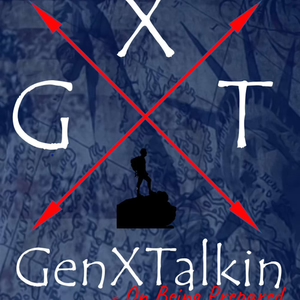
GXT Interviews - September 11 Special Episode
GXT-I-EP06
Hey there genx family. Our show today is meant to serve as a tribute and a time of reflection. Matt and Ed are joined by Matt's wife Kristin to take part in this special episode. She will share some additional thoughts on what the attacks meant to her, and to our family.
This special episode began as a concept, when Ed and I first started the whole podcast adventure. Ed realized how close we were to the 20th anniversary of the September 11 terrorist attacks on America... and what better way to talk preparedness for a nation, then to remember one of the worst attacks we’ve ever experienced.
We both recognized we needed to have a special episode. We started asking some of our friends and family about their experiences. From that, we found a number of people willing to share their memories of that day, as well as talk about how their lives were affected.
Check out those episode as well on the podcast.
We referred to the following items as well throughout the episode:
https://www.nationalgeographic.com/tv/shows/911-one-day-in-america
https://www.goodreads.com/book/show/110890.The_Looming_Tower
https://www.goodreads.com/book/show/527262.1000_Years_for_Revenge
https://www.goodreads.com/book/show/232631.Let_s_Roll_
Hope you enjoy!
@genxtalkin
Would you be prepared? Are you prepared?
Choosing to be more prepared every day is a skill. One that should be honed. Focusing on growing just a little everyday will allow us all to be prepared to respond well and recover faster.
I’d love to hear your thoughts and comments about prepping, so please reach out and share as you can.
Until next time... this is monk signing off... better be prepared
Next Episode

GenXTalkin Making a Plan - Communications Planning GXT-EP05-02
RESOURCES:
YOUTUBE VIDEO
https://youtu.be/i7swLmicckc
https://www.ready.gov/
National Risk Index MAP
https://hazards.fema.gov/nri/map
I’m Matt Damon
https://youtu.be/gnPWJOJYVKc
Bourne Identity Scene
https://youtu.be/dsJiYWv3J00
Planning Your Communications
Most important here is understanding how important it is to have proper communications. Without communications, how will we know:
where to meet up
when to meet up
what do we do when the first meet up location fails
What are our next steps
what direction I'm headed
or simply... is my family OK?
Start with the basics for the Communications Plan. First, collect important information such as phone numbers; for each other, for friends and family, for doctors, hospitals, dentists, ob-gyn, etc. Collect information around children's school (including college), and adult workplace emergency plans. Where will the kids be taken (and how, by bus?) in a time of emergency? Always include out of town contacts to use as go-between during large events, and establish a time to check in at regular intervals.
establish meeting places ahead of time for additional purposes.
Indoor - in case of extreme weather, such as tornadoes
In your neighborhood - like the neighbor's front porch in case you can't get into your home
Outside your neighborhood - to meet up if you're not at home during emergencies and cannot cannot get there
Outside your own town or city, or even state or region - for cases in which you cannot get home and you've been instructed to evacuate the area
Make small laminated sheets for each to hold in a wallet, purse or backpack. Having this information handy will allow each family member to respond well and recover faster.
Consider adding a couple of apps to your smartphone. Many of these groups create their own smartphone apps, but they also have directed us to the following:
AED
PulsePoint
USNG
CodeRed
311
ERG2020
Compass
Broadcastify
One of the problems that often occurs during natural disasters is that cell phone services get "clogged". So, start with just texting instead.
Try to find additional locations at which you can connect to the internet via WIFI. Of course, you want to make sure this is actually a free service. Very frustrating when you're in the midst of an emergency, and you have to enter a credit card, or email information to gain access. Also, a good reason to plan this ahead is you also want the ability to recognize the WIFI network you're using. Whether emergency or not, you never want to transmit your personal data, unprotected by VPN, across an unknown WIFI network!
Lastly, you should come to realize that preparedness does not stop at the end of National Preparedness Month... Keep going, and remember that "practice makes PROGRESS!"
@genxtalkin
Would you be prepared? Are you prepared?
Choosing to be more prepared every day is a skill. One that should be honed. Focusing on growing just a little everyday will allow us all to be prepared to respond well and recover faster.
I’d love to hear your thoughts and comments about prepping, so please reach out and share as you can.
Until next time... this is monk signing off... better be prepared
If you like this episode you’ll love
Episode Comments
Generate a badge
Get a badge for your website that links back to this episode
<a href="https://goodpods.com/podcasts/genxtalkin-on-being-prepared-236864/genxtalkin-making-a-plan-shelter-in-place-and-evacution-planning-gxt-e-26409834"> <img src="https://storage.googleapis.com/goodpods-images-bucket/badges/generic-badge-1.svg" alt="listen to genxtalkin making a plan - shelter in place and evacution planning gxt-ep05-01 on goodpods" style="width: 225px" /> </a>
Copy
